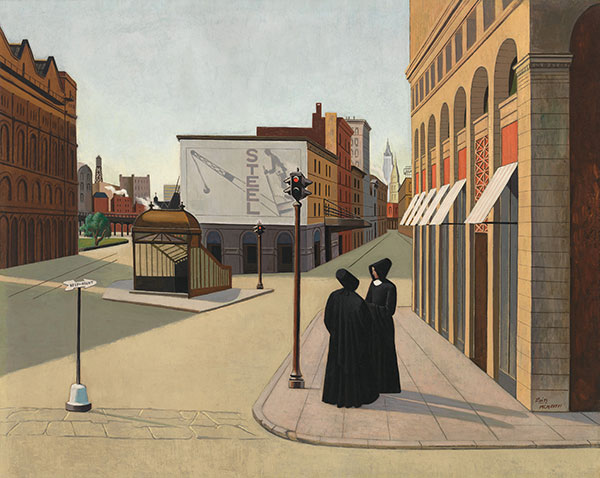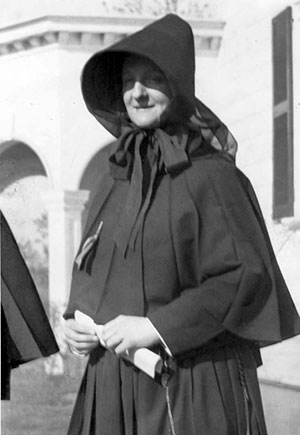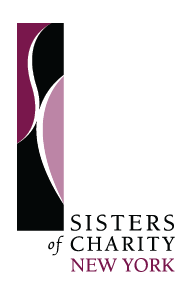By Mindy Gordon, Director, Archives and Museum


Most art critics would agree that Astor Place, a Surrealist artwork by Francis Criss, would be a welcome addition to any collection of 20th Century art. At first look, one would immediately understand why this unique piece is of particular interest to the Sisters of Charity of New York. Purchased by the Whitney Museum of American Art in Manhattan for its perma-nent collection, the painting was exhibited at the museum’s First Biennial Exhibition of Contemporary American Painting held November 22, 1932, to January 5, 1933. Central to the painting is two women cloaked in black engaged in conversation on a sidewalk near the Astor Place subway station in Greenwich Village.
In this view, the Cooper Union building can be seen to the left side of the paintings, and in the distance, a glimpse of the Third Avenue elevated train tracks. Recognizable as Sisters of Charity of New York, they wear black floor-length cloaks with white collars and the distinct cone-like outdoor hat or “coal scuttle” worn during the first half of the 20th century. An authentic sample is preserved in the archives of the Community.
Contemporary art critic Joanna Shaw-Eagle, has described the painting:
Two nuns talking on a New York City sidewalk in front of a strange Italian Renaissance-looking building. Mr. Criss reduced the two women to simplified cone-like shapes… in the center of the street, a low signpost topped by an arrow that says, “Keep Right.” It was one of the images that earned him an admired reputation in the New York art world of the 1930s.”
The Washington Post, August 11, 2001
The sisters were a presence in lower Manhattan beginning in 1817 when Mother Elizabeth Seton sent three sisters from Emmitsburg, Md., to care for orphaned children. In 1932, when Criss created the painting, the presence of the Sisters of Charity of New York in Greenwich Village was prominent.
Sisters of Charity missions in the area included St. Ann School on 11th Street, St. Vincent’s Hospital and Nursing school on 12th Street, and St. Joseph Academy in the Washington Square neighborhood. The site of St. Joseph Academy remains a residence for sisters today, allowing the Community to maintain a presence in Greenwich Village.
The tradition of teaching, health care and caring for the city has been the legacy of the Sisters of Charity of New York for over 200 years. The Congregation’s legacy will forever be associated with New York City’s history and, with gratitude to Francis Criss, its art, too.
Francis Criss
Modernist painter Francis Criss (1901–1973) was born in London to a Jewish-Russian family who immigrated to the U.S. in 1904. While recuperating from polio as a boy, he discovered a talent for drawing. He studied at the Pennsylvania Academy of Art and the Art Students League in New York City; he was awarded the prestigious Pennsylvania Academy’s Cresson scholarship. Criss worked for the Works Progress Administration during the 1930s–1940s.

Thank you for some historical data about the Sisters of Charity, NY… by the way the cone shape head covering is interesting, always thought the Sisters wore a bonnet